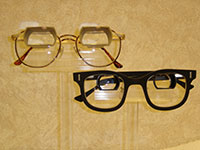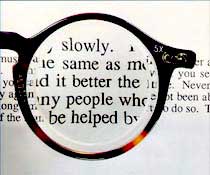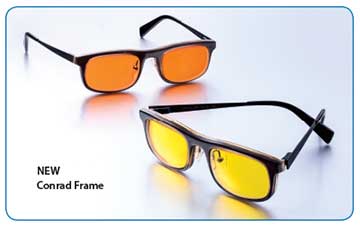Customized Low Vision Aids
Customized low vision aids are specialized devices meticulously designed to assist individuals with visual impairments, offering tailored solutions to enhance their daily functionality. These aids, ranging from magnifiers to electronic devices, are personalized to address the unique visual challenges of each individual, maximizing their remaining vision and enabling them to perform tasks such as reading, writing, and navigation more independently. Through a collaborative process involving optometrists and low vision specialists, these aids are precisely calibrated to match the specific needs and goals of the user, ultimately improving their overall quality of life and fostering greater self-sufficiency.
Absorptive Lenses

Absorptive lenses, also known as absorptive filters or simply absorptive glasses, are optical devices designed to selectively absorb specific wavelengths of light while allowing other wavelengths to pass through. These lenses are commonly used in various applications to manage and control light intensity, reduce glare, and enhance visual comfort. They work on the principle of absorption, where certain materials are integrated into the lens to absorb targeted wavelengths of light, such as ultraviolet (UV) or infrared (IR) radiation. Absorptive lenses find widespread use in industries such as eyewear, photography, laser protection, and scientific research.
One prominent application of absorptive lenses is in UV protection eyewear. These lenses are engineered to absorb harmful ultraviolet rays from the sun, safeguarding the eyes and surrounding skin from potential damage. Another essential application lies in laser safety eyewear, where absorptive lenses are employed to shield the eyes from intense laser beams by selectively absorbing the laser's wavelength, preventing potential eye injury. In addition, photographers often use absorptive filters to manipulate the color spectrum and create artistic effects in their images. The versatility and effectiveness of absorptive lenses make them indispensable tools in various domains where precise control over light transmission and absorption is crucial.
Bioptic Telescopes

Low Vision Bioptic Telescopic glasses, commonly referred to as bioptic glasses or simply bioptics, are specialized visual aids designed to assist individuals with low vision in various daily tasks. These glasses incorporate a small telescope or magnifying system mounted on the lenses, providing the user with enhanced visual acuity for specific purposes. Here's a brief overview of low vision bioptic telescopic glasses:
Telescope Integration: The defining feature of bioptic glasses is the integration of a miniature telescope into the lenses. The telescope is positioned in the upper portion of the lens, allowing users to look through it by tilting their head slightly downwards.
Varied Magnification: Bioptic telescopic glasses offer adjustable magnification levels, typically ranging from 2x to 8x or more. The Low Vision Specialist will determine what level of magnification is appropriate based on the patients specific visual needs for various tasks.
Dual Functionality: Unlike conventional telescopes, which are used independently of regular eyeglasses, bioptic glasses serve a dual function. The lower portion of the lens contains the user's prescription for regular vision, while the telescope provides the additional magnification for distance viewing.
Field of View: The field of view through the telescope is relatively narrow compared to regular vision, focusing on a small area of interest. As a result, bioptic glasses are most effective for brief glimpses of distant objects or details, rather than continuous long-distance viewing.
Training and Adaptation: The successful use of bioptic telescopic glasses requires proper training and adaptation. Users need to learn how to efficiently switch between regular vision and the telescope view, as well as how to stabilize their head and maintain peripheral awareness.
Specific Applications: Bioptic telescopic glasses are commonly used for tasks such as reading signs as is needed while driving, recognizing faces from a distance, watching TV, or enjoying scenic views. They can be especially beneficial for individuals with conditions like macular degeneration, retinitis pigmentosa, or other forms of low vision.
Customization: Bioptic glasses can be customized to meet the individual needs of users. Factors such as the level of magnification, field of view, and mounting position of the telescope can be tailored based on the user's visual impairment and preferences.
It's important to note that bioptic telescopic glasses may not be suitable for everyone with low vision, and their effectiveness varies depending on the specific eye condition and visual impairment of the user. An eye care professional specializing in low vision can assess the individual's needs and determine whether bioptic glasses are a viable option, as well as provide training and support for their proper use.
Clearimage II

ClearImage II represents a cutting-edge advancement in the field of image processing and enhancement. This sophisticated software leverages a combination of advanced algorithms and computational techniques to deliver exceptional image clarity and detail. Whether you're dealing with scanned documents, photographs, or digital images, ClearImage II offers a comprehensive solution for enhancing image quality by reducing noise, sharpening edges, and improving overall visual fidelity.
One of the standout features of ClearImage II is its ability to intelligently analyze images and apply targeted enhancements, resulting in striking improvements without sacrificing authenticity. With its user-friendly interface, both professionals and casual users can easily navigate through the software's toolkit, accessing functions such as deblurring, denoising, and color correction. Whether you're restoring old photographs or fine-tuning images for professional presentations, ClearImage II stands as a powerful tool that unlocks the full potential of your visual content.
Digial Solutions

Digital solutions have revolutionized the landscape of eyecare and low vision support, offering a range of innovative tools and applications designed to enhance the quality of life for individuals with visual impairments. These solutions leverage the power of technology to provide personalized assistance and accessibility. From mobile apps that magnify text and images to wearable devices that offer real-time visual cues, digital advancements are enabling those with low vision to engage more effectively with the world around them. By harnessing the capabilities of smartphones, tablets, and specialized devices, these digital solutions empower individuals to read, navigate, and interact with confidence, fostering independence and a sense of inclusion in daily activities.
Among the array of digital solutions for low vision, there are applications specifically tailored to aid in reading, object recognition, and even navigation. These tools utilize optical character recognition (OCR) to convert printed text into audible speech, making books, documents, and menus accessible. Furthermore, digital magnifiers offer adjustable magnification levels, high-contrast settings, and illumination control to accommodate various visual needs. As wearable technology advances, smart glasses and augmented reality (AR) devices are emerging to provide real-time information overlay, enhancing the user's understanding of their environment. Overall, these digital solutions are reshaping the landscape of eyecare and low vision support, promoting greater autonomy and inclusivity for individuals with visual challenges.
E-Scoop® Glasses

E-Scoop® glasses were developed to bridge the gap between standard eyeglasses and head borne telescopes. Whether your difficulty be night driving, bright light, sunlight, or simply seeing clearly in the distance, the E-Scoop® lens will help you see better.
The E-Scoop® lens is comprised of five optical properties: custom tint, anti-reflective coating, special lens thickness, base curve, and prism. When these five optical properties are combined into the E-Scoop lens, the image is enhanced and shifted to a different part of the retina (back part or "camera film" of the eye) allowing the patient to see better.
Prismatic Glasses

Prismatic glasses stand as a remarkable innovation within the realm of low vision aid, offering a specialized optical solution to enhance visual clarity and expand the field of view for individuals with visual impairments. These glasses incorporate prisms, which are specially designed pieces of glass that bend and redirect light, thereby altering the path that light takes as it enters the eyes. By strategically placing prisms within the lenses, prismatic glasses can effectively address issues such as visual field loss, double vision, and peripheral vision limitations. This makes them particularly valuable for those with conditions like macular degeneration, glaucoma, and other low vision challenges.
The effectiveness of prismatic glasses lies in their ability to shift and direct light to parts of the retina that still retain functional vision. This redirection can help users see objects that would otherwise fall outside their visual field. Prismatic glasses come in various configurations, including full frames, clip-ons, and over-glasses models, allowing individuals to choose the style that best suits their needs. Furthermore, these glasses can be custom-made to cater to each user's specific prescription and degree of visual impairment. As prismatic glasses continue to evolve with advancements in optical technology, they offer a renewed sense of independence and improved visual experiences for those with low vision, enabling them to navigate their surroundings more effectively and engage more fully in everyday activities.
Reading Telescopes

Reading telescopes emerge as a valuable tool in the world of low vision aids, catering to individuals with visual impairments who seek to regain the ability to read and engage with printed materials. These telescopic devices integrate advanced optical technology to magnify text and images, enabling users to comfortably read books, newspapers, labels, and more. Designed with portability and convenience in mind, reading telescopes are often handheld and lightweight, making them easily transportable for various reading situations. These devices employ a combination of lenses and prisms to achieve magnification without sacrificing image quality, which is especially beneficial for individuals with conditions like macular degeneration or other central vision impairments.
What sets reading telescopes apart is their adaptability to different reading distances. Unlike traditional magnifying glasses that require the user to maintain a fixed distance from the text, reading telescopes offer adjustable focus settings that allow users to choose their preferred working distance. This feature accommodates varying visual needs and preferences, granting users the flexibility to read comfortably without straining their eyes. With the aid of reading telescopes, individuals with low vision can once again engage with written content independently, fostering a sense of empowerment and reducing the barriers posed by visual impairments.
Side Vision Awarness Glasses (SVAG)

Side Vision Awareness Glasses (SVAG) represent a groundbreaking advancement in the field of eyecare, offering a revolutionary solution to enhance peripheral vision and situational awareness for individuals with visual impairments. Traditional eyewear often focuses solely on improving central vision, neglecting the crucial role that peripheral vision plays in navigating the environment safely. SVAG addresses this limitation by incorporating cutting-edge technology that extends the wearer's field of view, enabling them to detect obstacles, pedestrians, and other objects from the sides without the need for constant head movement. This innovation not only empowers those with visual impairments to confidently move about their surroundings but also enhances their overall quality of life by reducing the risk of accidents and fostering a greater sense of independence.
At the core of SVAG is a sophisticated system that combines miniature cameras and advanced image processing algorithms. These components work in harmony to capture real-time visual information from the wearer's surroundings, which is then seamlessly integrated into the display of the glasses. This display is strategically positioned within the wearer's peripheral vision, ensuring that the additional information doesn't overwhelm or obstruct their central vision. The result is a comprehensive visual experience that provides a comprehensive awareness of the environment, bridging the gap between central and peripheral vision. SVAG holds immense potential not only for individuals with visual impairments but also for various applications such as sports, navigation, and professions that demand heightened situational awareness, contributing to a safer and more inclusive society for all.